Contemporary dance is a liberating and expressive art form. Are you eager to express yourself through movement and explore the world of contemporary dance? At ten-dance.com, we provide comprehensive resources and guidance to help you start your contemporary dance journey, enabling you to move with intention and emotion. Discover the freedom and artistry of contemporary dance with us, where you’ll find dance techniques, emotional expression, and creative movement.
1. What Is Contemporary Dance?
Contemporary dance is a dynamic dance genre characterized by its emphasis on self-expression and freedom of movement. It offers a departure from the rigidity found in traditional dance styles.
Contemporary dance draws inspiration from ballet and jazz but distinguishes itself through its innovative, non-traditional approach. According to a study by the Juilliard School in July 2023, contemporary dance allows dancers to express themselves more freely than classical forms, making it a popular choice for those seeking artistic individuality.
Key aspects of contemporary dance include:
- Freedom of Expression: Focuses on expressing personal feelings and emotions through movement.
- Versatile Movements: Incorporates elements from various dance styles, including acrobatics, martial arts, and yoga.
- Storytelling: Uses movement to convey narratives and themes, connecting dancers and audiences on an emotional level.
- Improvisation: Encourages dancers to explore spontaneous and creative movements, allowing for unique and personal interpretations.
- Emotional Connection: Aims to create a profound connection between the dancer’s inner feelings and their physical expressions.
Contemporary dance is a genre that values personal interpretation and emotional depth, making it an appealing option for dancers seeking artistic expression.
2. Why Learn Contemporary Dance?
Contemporary dance allows you to connect with yourself on both physical and artistic levels, offering numerous benefits.
If you are looking for a dance style that promotes self-expression and creativity, contemporary dance is an excellent choice. According to research from the American Dance Therapy Association in June 2024, contemporary dance can significantly enhance emotional expression and physical awareness.
Key benefits of learning contemporary dance include:
- Emotional Expression: Contemporary dance helps you communicate your emotions through nuanced and intentional movements.
- Physical Artistry: You’ll improve your ability to create clean lines and aesthetically pleasing shapes with your body.
- Musicality: If you’re familiar with other dance styles like hip hop, popping, or house, contemporary dance will enhance your musicality skills by encouraging you to think outside the box.
- Full-Body Engagement: Contemporary dance engages muscles you never knew you had, promoting overall strength and flexibility.
- Creative Exploration: You’ll learn to create unique movements and pictures, fostering creativity and innovation.
Consider exploring contemporary dance if you seek a style that offers physical and artistic benefits. At ten-dance.com, we provide resources and guidance to help you embark on this enriching dance journey.
3. How Do I Prepare For A Contemporary Dance Class?
Preparing adequately for a contemporary dance class ensures comfort and readiness to fully engage in the session. Consider what to wear, how to prep your space, and how to prep your body.
3.1. What to Wear
Wear clothing that allows a full range of motion, ensuring you can move freely and comfortably. According to a study by the National Dance Education Organization in May 2023, appropriate attire can significantly enhance a dancer’s performance and reduce the risk of injury.
Recommended attire includes:
- Loose Tops: Breathable tops that don’t restrict movement.
- Comfortable Bottoms: Loose pants or shorts that allow for a wide range of motion.
- Bare Feet or Socks: Dance barefoot to feel connected to the floor, or wear socks for smoother movements on carpeted surfaces.
 Loose Clothing for Contemporary Dance
Loose Clothing for Contemporary Dance
3.2. How to Prep Your Dance Space
Clear a safe and open space for dancing at home to prevent injuries and allow for unrestricted movement. A minimum of 6ft by 6ft is generally recommended.
Steps to prepare your dance space:
- Clear Obstacles: Remove any furniture or objects that could obstruct your movements.
- Check for Hazards: Ensure there are no sharp edges or tripping hazards in the area.
- Adequate Lighting: Make sure the space is well-lit to avoid accidents and enhance visibility.
3.3. How to Prep Your Body
Strengthening your core and lower body is crucial for executing fluid and powerful contemporary dance movements.
Recommended preparation steps:
- Core Exercises: Dedicate 10-15 minutes daily to strengthen your back and abs with exercises like planks and crunches.
- Balance Exercises: Improve stability by balancing on one foot, which also enhances your core strength.
- Flexibility Exercises: Incorporate gentle yoga routines and stretching to increase your range of motion.
- Warm-Up: Always warm up your body with light cardio and stretching before each class to prevent injuries.
By properly preparing your attire, dance space, and body, you’ll be well-equipped to maximize your contemporary dance experience. At ten-dance.com, we offer resources and tips to help you prepare effectively for your dance sessions.
4. What Should I Look For In A Beginner Contemporary Dance Class?
Beginner contemporary dance classes should thoroughly cover basic techniques while fostering exploration and building an artistic foundation.
When choosing a beginner class, consider the following:
- Fundamental Techniques: Ensure the class covers essential techniques like chassés and ball changes, explaining different ways to execute them for varied visual effects.
- Instructor Interaction: Look for instructors who encourage exploration and help you understand how your body moves specifically.
- Interactive Environment: Expect the class to be interactive, with questions and opportunities for improvisation and freestyling.
According to Karen Chuang, a contemporary dance instructor at STEEZY Studio, the best classes are immersive and personal, allowing you to connect with your dancing in a meaningful way.
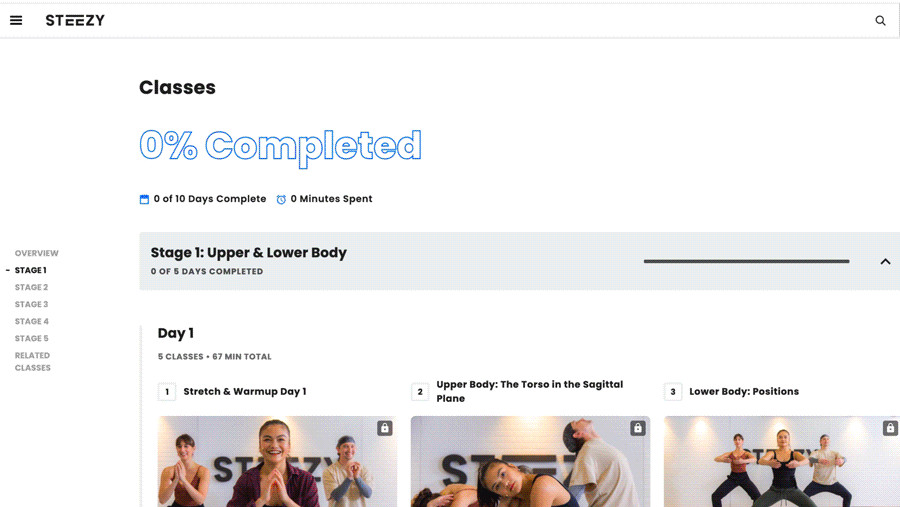 Contemporary Dance Program
Contemporary Dance Program
Selecting a class that focuses on technique, exploration, and personal expression is crucial for beginners. Ten-dance.com offers a variety of classes and resources to help you find the perfect fit for your dance journey.
5. Contemporary Dance Tips For Beginners
To excel in contemporary dance, beginners should focus on building body awareness, understanding eye contact, exploring movement qualities, practicing safe movements, and familiarizing themselves with foundational dance styles.
5.1. Build Body Awareness
Developing a strong connection between your brain and muscles is essential for dancing with emotional intensity and grace.
To improve body awareness:
- Stretch Exercises: Use stretching to get in tune with your body. For example, slowly lower your chest to the floor and back up, focusing on activating each back muscle.
- Body Awareness Videos: Follow videos that guide you in moving specific points on your body along an imaginary grid.
- Isolated Movements: Practice moving one body part at a time while keeping the rest of your body still to build muscle memory.
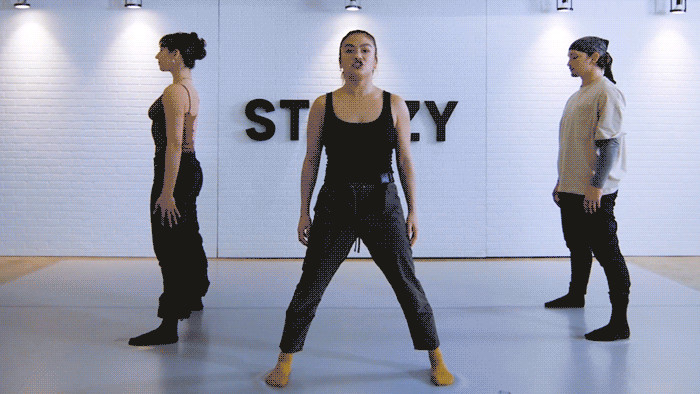 Rolldown Exercise for Body Awareness
Rolldown Exercise for Body Awareness
5.2. Understand Eye Contact & Chin Lines
Contemporary dancers use their faces to add emotional context to their movements. The direction of your eyes and chin can significantly impact the story you’re telling.
Practice different expressions in the mirror to see how subtle changes in your chin angle and eye focus can convey different emotions. Use these expressions to enhance your dance performances.
- Arrogance: A raised chin and direct gaze can convey confidence or arrogance.
- Neutrality: A level chin and soft gaze can create a sense of calm or neutrality.
- Flirtatiousness: A slightly lowered chin and playful eyes can express flirtation or coyness.
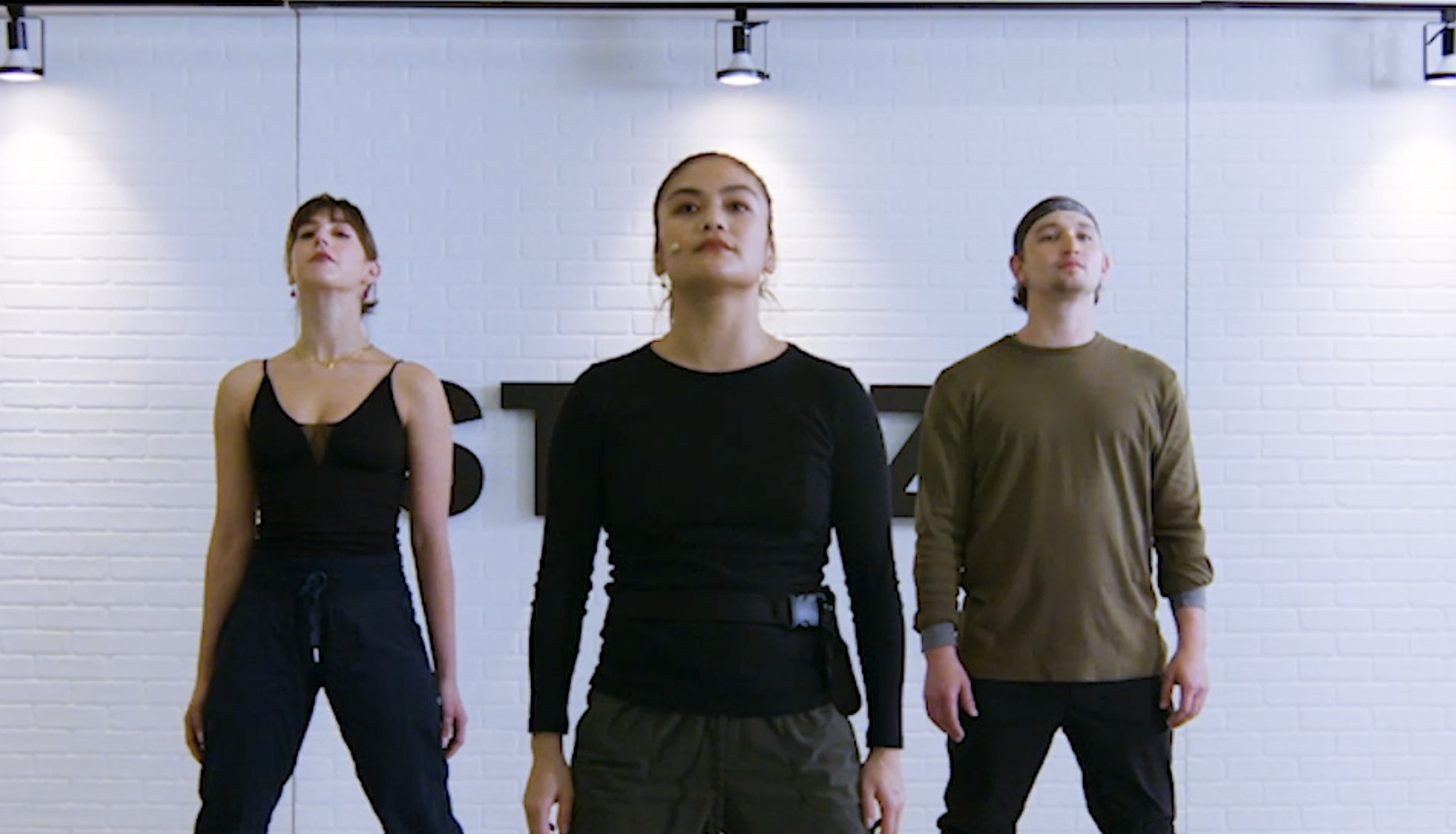 Arrogant Facial Expression
Arrogant Facial Expression
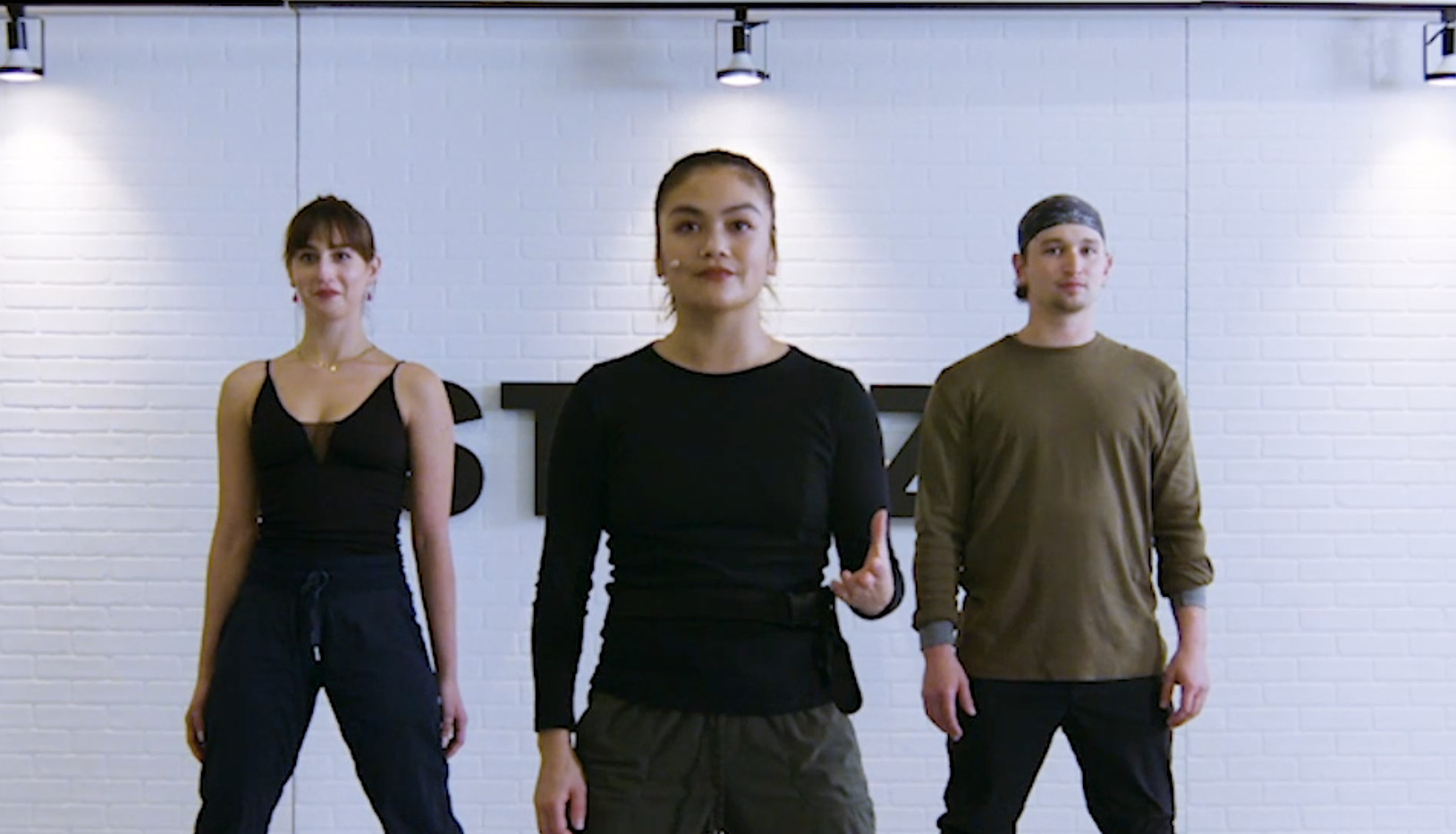 Neutral Facial Expression
Neutral Facial Expression
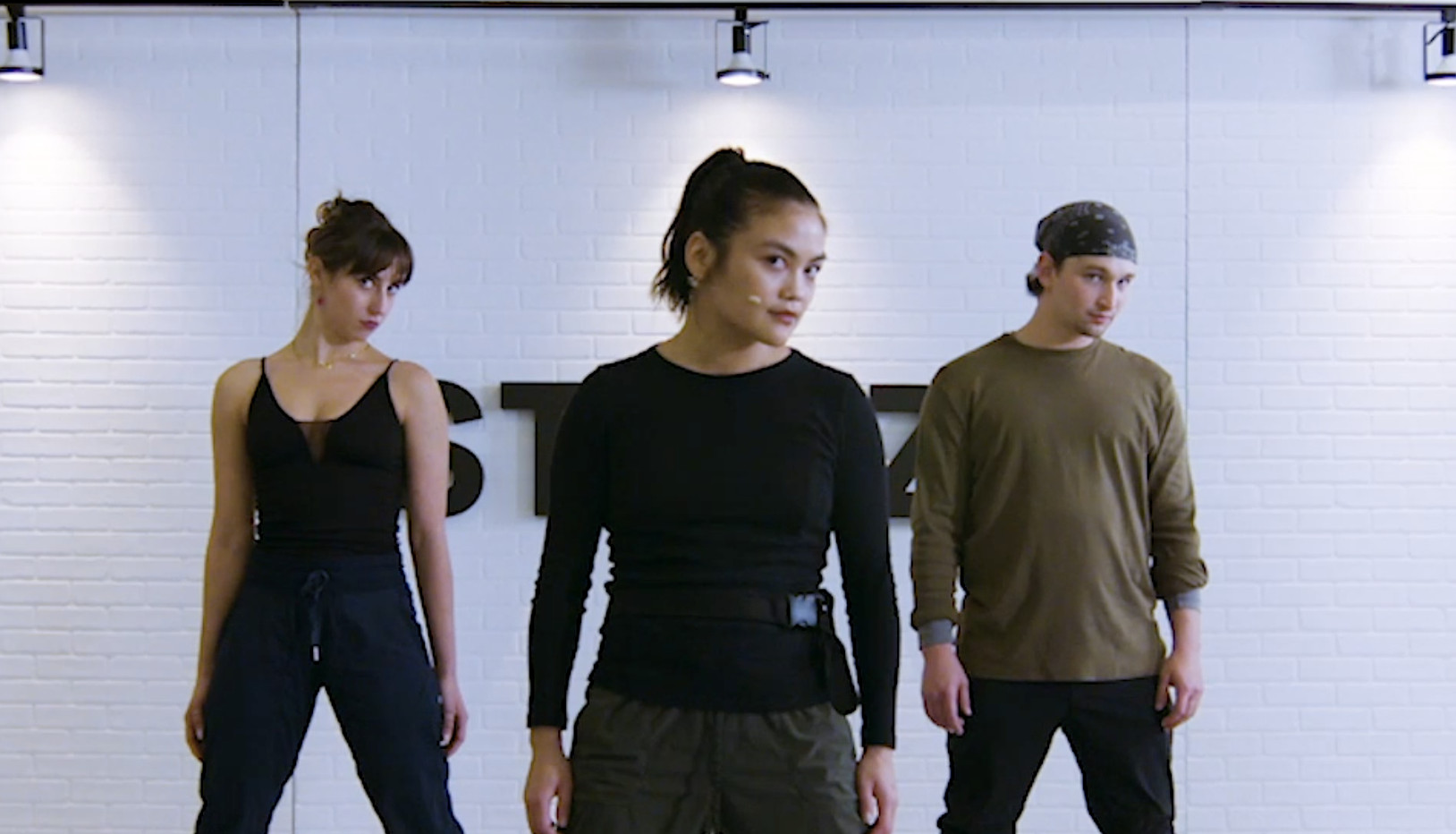 Flirtatious Facial Expression
Flirtatious Facial Expression
5.3. Explore Different Movement Qualities
Understanding and mastering different movement qualities will expand your abilities as a contemporary dancer. The Laban effort qualities, which include flow, time, weight, and space, are particularly useful for beginners.
- Flow: This refers to whether your movements feel free or resisted.
- Time: This refers to whether your movements are sudden or slow.
- Weight: This refers to whether your movements appear heavy or light.
- Space: This refers to whether you move directly or indirectly from one place to another.
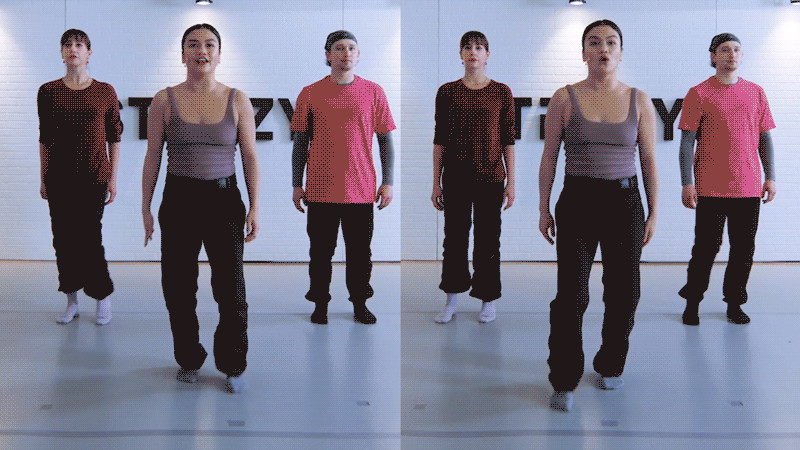 Sudden vs Slow Movement
Sudden vs Slow Movement
 Heavy vs Light Movement
Heavy vs Light Movement
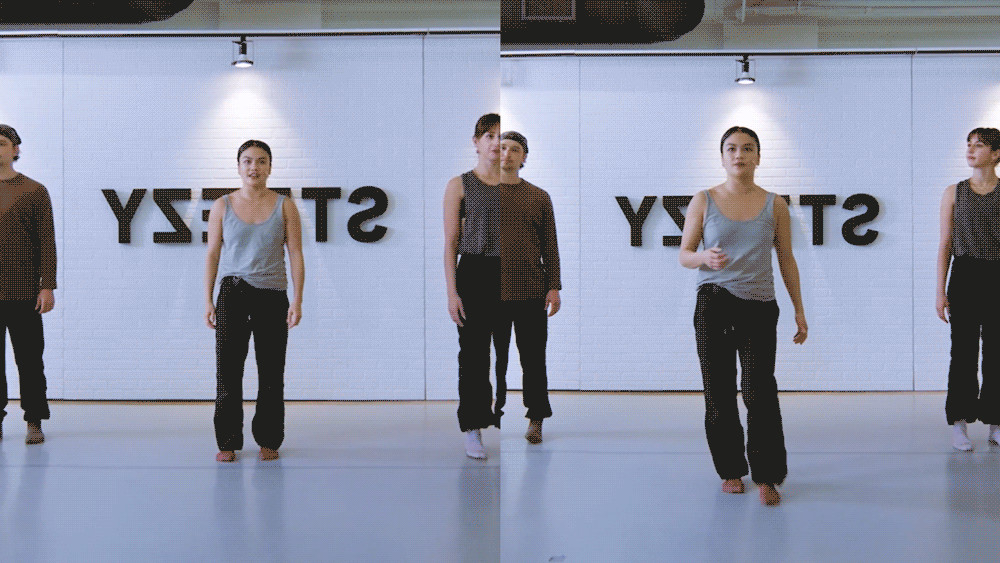 Direct vs Indirect Movement
Direct vs Indirect Movement
5.4. Practice Safe Movements
To avoid injuries, pay close attention to the pathways your instructor takes to move from one position to the next.
Safety tips include:
- Use Your Hands: When moving to the floor, use your hands to support your body.
- Soft Landings: When rolling on the ground, use the softest parts of your body as your main point of contact.
- Proper Jumping Technique: When jumping, land on the balls of your feet to absorb the shock.
- Listen to Your Body: If a movement feels painful, ask your instructor for alternatives or safety tips.
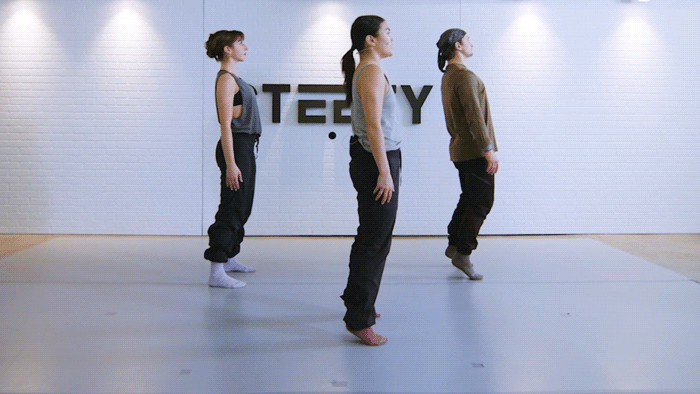 Using Hands for Support
Using Hands for Support
5.5. Familiarize Yourself with Ballet, Jazz, and Other Foundations
Contemporary dance draws from various styles, so understanding the basics of ballet, jazz, and other foundational techniques can be beneficial.
Essential moves that carry from style to style include:
- Ball Changes: A quick transfer of weight from one foot to the other.
- Pivot Turns: A turn executed on the ball of the foot while the body pivots.
- Chassés: A gliding step where one foot chases the other.
- Pas de Bourrées: A series of quick, connecting steps.
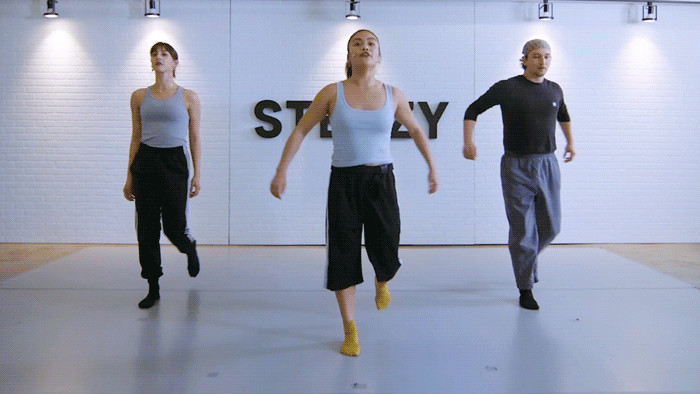 Ball Change
Ball Change
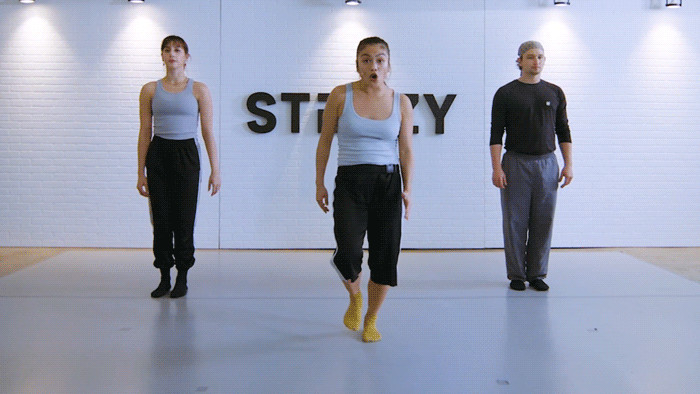 Pivot Turn
Pivot Turn
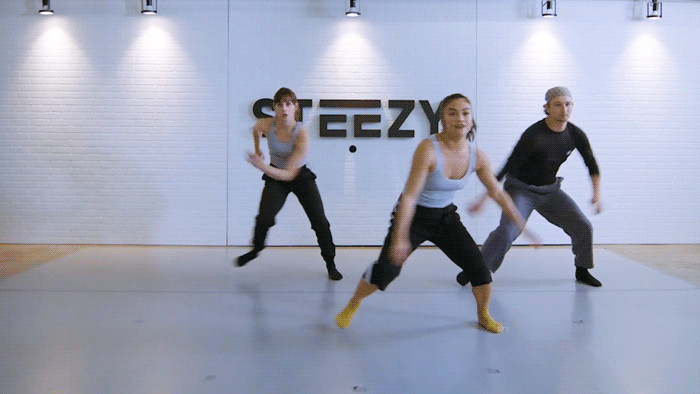 Chassé
Chassé
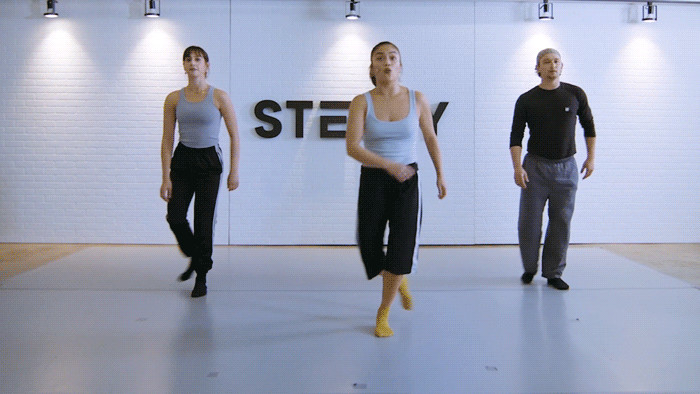 Pas de Bourrée
Pas de Bourrée
By focusing on body awareness, understanding facial expressions, exploring movement qualities, practicing safe movements, and familiarizing yourself with foundational dance styles, you can build a solid foundation in contemporary dance. Ten-dance.com provides resources and classes to support your dance education.
6. How Do Journaling & Improvisation Hone My Craft?
Journaling and improvisation are valuable tools for contemporary dancers, helping to deepen emotional expression and develop unique movement vocabularies.
When you perform a dance, recalling a powerful memory that fits the choreography can enhance your emotional connection to the piece.
6.1. Journaling for Emotional Depth
- Regular Practice: Take time to journal regularly, documenting your own powerful experiences to make them easier to recall.
- Detailed Descriptions: Don’t spare any details when writing. Think about what you wore, how the space smelled, and how your body felt.
- Emotions Wheel: If you’ve never journaled before, use an emotions wheel to select a feeling and write about a time you experienced it.
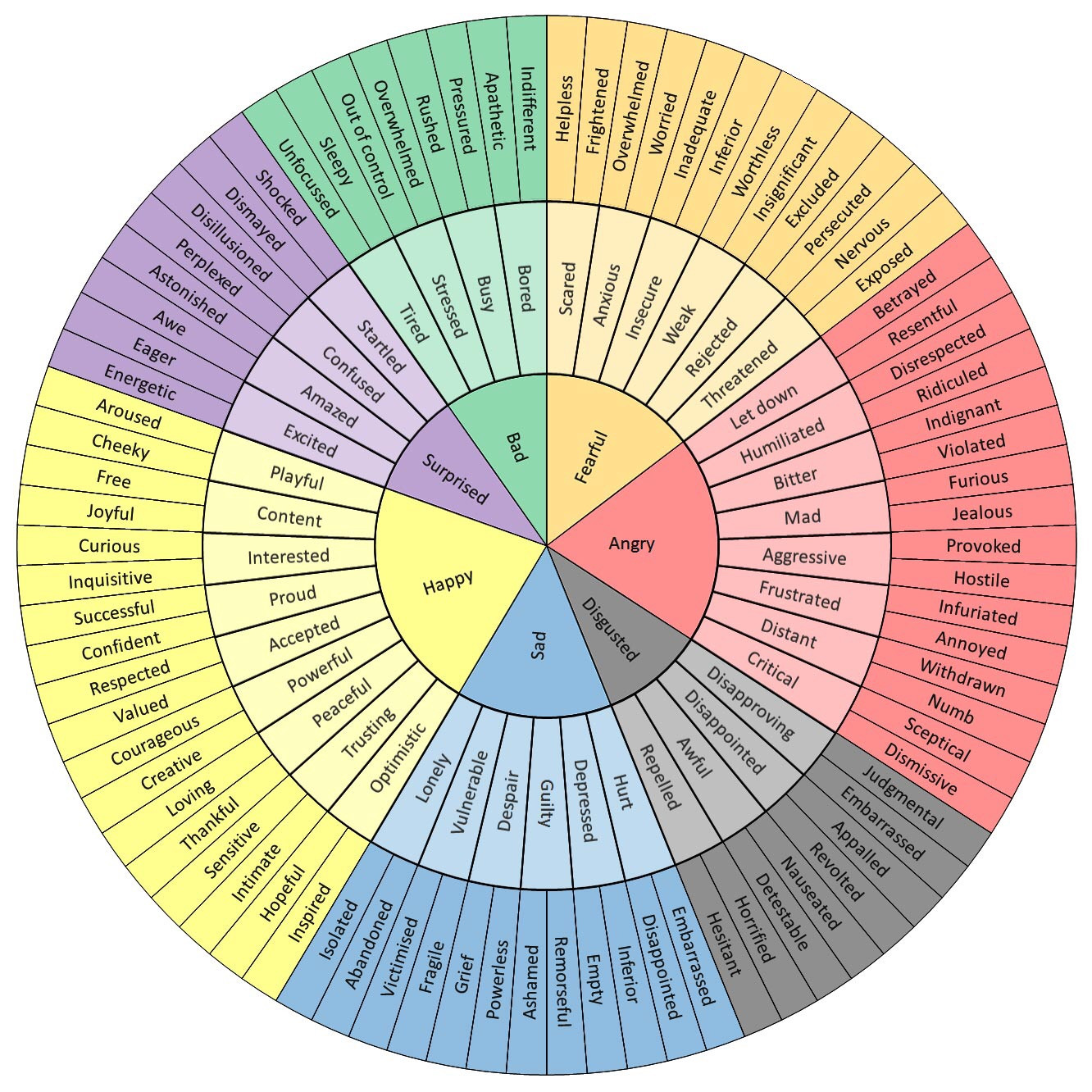 Emotions Wheel
Emotions Wheel
6.2. Improvisation for Movement Exploration
- Fantasy Scenarios: Put on a song that evokes strong feelings and imagine a fantasy situation that fits the music.
- Free Movement: Improvise a dance where you’re the main character in that fantasy.
According to Karen Chuang, a contemporary instructor at STEEZY, “Improv is a great way to explore how your body moves outside of structure, break habits, and discover new things.”
Incorporating journaling and improvisation into your dance practice can significantly enhance your emotional depth and movement creativity. Ten-dance.com offers resources and exercises to help you develop these skills.
7. Where Can I Find Contemporary Dance Classes in New York?
New York City boasts a vibrant dance scene with numerous options for contemporary dance classes. From beginner to advanced levels, you can find a class that suits your interests and skills. Here are some top places to explore:
-
The Ailey Extension: Located at 405 W 55th St, New York, NY 10019, this extension of the Alvin Ailey American Dance Theater offers a wide range of contemporary dance classes for all levels. Their classes focus on technique, improvisation, and creative expression. Phone: +1 (212) 405-9500.
-
Broadway Dance Center: Situated at 322 W 45th St, New York, NY 10036, Broadway Dance Center is known for its diverse class offerings, including contemporary dance. They provide classes for both beginners and professionals, taught by experienced instructors. Phone: +1 (212) 582-9304.
-
Peridance Capezio Center: Found at 126 E 13th St, New York, NY 10003, Peridance offers a comprehensive contemporary dance program with classes for all ages and skill levels. Their faculty includes renowned choreographers and dancers. Phone: +1 (212) 505-0886.
-
Steps on Broadway: Located at 2121 Broadway, New York, NY 10023, Steps on Broadway provides a wide array of dance classes, including contemporary. Their classes cater to various levels, from absolute beginners to advanced dancers. Phone: +1 (212) 874-2410.
-
Gibney Dance: With locations at 280 Broadway, New York, NY 10007, and 890 Broadway, New York, NY 10003, Gibney Dance is a hub for contemporary dance, offering classes, workshops, and performances. They focus on community engagement and artistic development. Phone: +1 (646) 837-6800.
Here’s a quick overview:
| Dance School | Address | Phone | Focus |
|---|---|---|---|
| The Ailey Extension | 405 W 55th St, New York, NY 10019 | +1 (212) 405-9500 | Technique, improvisation, creative expression |
| Broadway Dance Center | 322 W 45th St, New York, NY 10036 | +1 (212) 582-9304 | Diverse classes, beginner and professional levels |
| Peridance Capezio | 126 E 13th St, New York, NY 10003 | +1 (212) 505-0886 | Comprehensive program, all ages and skill levels |
| Steps on Broadway | 2121 Broadway, New York, NY 10023 | +1 (212) 874-2410 | Wide array of dance classes, various levels |
| Gibney Dance | 280 Broadway & 890 Broadway, New York, NY 10003 | +1 (646) 837-6800 | Community engagement, artistic development, classes, workshops, performances |
Consider your level, preferred location, and specific interests when choosing a class. Most of these schools offer trial classes or introductory packages to help you find the perfect fit.
8. How Can I Integrate Contemporary Dance into My Fitness Routine?
Incorporating contemporary dance into your fitness routine can provide a fun and effective way to improve your physical health and well-being. Contemporary dance offers a full-body workout that enhances strength, flexibility, and cardiovascular health. Here are several ways to integrate it into your fitness regimen:
- Replace Cardio: Instead of traditional cardio exercises like running or cycling, try a contemporary dance class. The dynamic movements and varied rhythms can provide an equally effective cardiovascular workout while engaging more muscle groups.
- Supplement Strength Training: Use contemporary dance to complement your strength training routine. The dance movements help improve balance, coordination, and core strength, enhancing the benefits of your weightlifting or bodyweight exercises.
- Enhance Flexibility: Dedicate time to stretching and flexibility exercises inspired by contemporary dance. Focus on lengthening your muscles, improving your range of motion, and preventing injuries.
- Active Recovery: Incorporate gentle contemporary dance movements as part of your active recovery routine. This helps reduce muscle soreness, improve circulation, and promote relaxation.
- Mind-Body Connection: Use contemporary dance to enhance your mind-body connection. Focus on the emotional expression and storytelling aspects of the dance to improve mindfulness and reduce stress.
Here is a simple routine:
| Day | Activity | Duration | Benefits |
|---|---|---|---|
| Monday | Contemporary Dance Class | 60 mins | Full-body workout, improves cardiovascular health and coordination |
| Tuesday | Strength Training | 45 mins | Builds muscle strength and endurance |
| Wednesday | Contemporary-Inspired Stretching | 30 mins | Improves flexibility and range of motion |
| Thursday | Active Recovery with Dance Movements | 30 mins | Reduces muscle soreness, improves circulation |
| Friday | Contemporary Dance Class or Free Improvisation | 60 mins | Enhances emotional expression, creativity, and mind-body connection |
By integrating contemporary dance into your fitness routine, you can enjoy a holistic approach to health and wellness that combines physical exercise with artistic expression.
9. What Are Some Common Misconceptions About Contemporary Dance?
Contemporary dance is often misunderstood due to its unconventional nature and emphasis on personal expression. Here are some common misconceptions and the truths behind them:
- Misconception: Contemporary dance is only for professionals.
- Truth: Contemporary dance is accessible to people of all ages and skill levels. Many studios offer beginner classes that focus on fundamental techniques and creative exploration.
- Misconception: You need a specific body type to be a contemporary dancer.
- Truth: Contemporary dance celebrates all body types. The focus is on expressing yourself through movement, not conforming to a particular aesthetic.
- Misconception: Contemporary dance is just random movements without technique.
- Truth: While contemporary dance emphasizes freedom and improvisation, it is grounded in technique. Dancers often draw from ballet, jazz, and modern dance techniques to execute complex movements with precision and control.
- Misconception: Contemporary dance is always serious and somber.
- Truth: Contemporary dance can explore a wide range of emotions and themes, including joy, humor, and playfulness. The tone of a contemporary piece depends on the choreographer’s vision and the dancers’ interpretation.
- Misconception: Contemporary dance is too abstract to understand.
- Truth: While some contemporary pieces may be abstract, they often convey meaningful messages and emotions. Engaging with contemporary dance requires an open mind and a willingness to interpret the movements and gestures.
Understanding these common misconceptions can help you approach contemporary dance with a more informed and appreciative perspective.
10. How Can I Stay Updated on Contemporary Dance Events and Workshops in the USA?
Staying informed about contemporary dance events and workshops is essential for dancers looking to expand their skills, connect with the dance community, and stay inspired. Here are several ways to stay updated on contemporary dance events and workshops in the USA:
- Dance Magazines and Websites: Subscribe to dance magazines and follow dance-related websites.
- Social Media: Follow dance companies, choreographers, and dance studios on social media platforms.
- Dance Organizations: Join dance organizations and associations.
- Email Newsletters: Subscribe to email newsletters from dance studios, companies, and organizations.
- Local Dance Studios: Check the websites and social media pages of local dance studios.
Here’s a list of contemporary dance events:
| Event | Location | Date | Description |
|---|---|---|---|
| American Dance Festival | Durham, NC | June-July | Renowned festival featuring performances, workshops, and intensives |
| Jacob’s Pillow Dance Festival | Becket, MA | June-August | Summer festival showcasing a wide range of dance styles, including contemporary |
| NYC Dance Week | New York, NY | June | Celebration of dance with free and discounted classes and performances |
| San Francisco Dance Film Festival | San Francisco, CA | October | Festival showcasing dance films from around the world |
| The Joyce Theater | New York, NY | Year-Round | Presents contemporary dance performances throughout the year |
By utilizing these resources, you can stay informed about the latest contemporary dance events and workshops in the USA and take advantage of opportunities to learn, grow, and connect with the dance community.
Your body already knows how to express itself. Contemporary dance is an exaggeration of familiar movements set to music. Everything you need is already inside you, now you just need to start.
Ready to move? Visit ten-dance.com today to explore our lessons, discover local classes, and connect with a vibrant community of dancers. Start your journey now and unleash your inner artist.
FAQ: How To Do Contemporary Dance
-
What exactly is contemporary dance?
Contemporary dance is a performance dance genre that developed during the mid-twentieth century and has since grown to become one of the dominant genres for formally trained dancers across the globe, with particularly strong popularity in the U.S. and Europe. -
What makes contemporary dance different from other styles?
Unlike more structured styles like ballet, contemporary dance prioritizes freedom of movement and personal expression. It often blends elements from various dance genres, including ballet, jazz, and modern dance, to create innovative and unique performances. -
Do I need prior dance experience to start contemporary dance?
No, prior dance experience is not necessary to begin learning contemporary dance. Many studios offer beginner classes that focus on fundamental techniques and creative exploration, making it accessible to people of all ages and skill levels. -
What type of clothing should I wear to a contemporary dance class?
You should wear clothing that allows a full range of motion and doesn’t restrict your movements. Loose tops, comfortable pants or shorts, and bare feet or socks are generally recommended. -
How can I improve my flexibility for contemporary dance?
You can improve your flexibility by incorporating stretching and flexibility exercises into your daily routine. Focus on lengthening your muscles, improving your range of motion, and preventing injuries. -
How important is emotional expression in contemporary dance?
Emotional expression is a core element of contemporary dance. Dancers use their movements, facial expressions, and gestures to convey a wide range of emotions and themes, connecting with the audience on an emotional level. -
What are some essential techniques in contemporary dance?
Some essential techniques in contemporary dance include floor work, improvisation, contact improvisation, and the use of breath and weight. These techniques help dancers explore movement possibilities and develop their personal style. -
How can I find contemporary dance classes near me?
You can find contemporary dance classes near you by searching online, checking local dance studios, and asking for recommendations from friends or other dancers. Websites like ten-dance.com also offer directories of dance classes and studios in your area. -
What role does music play in contemporary dance?
Music plays a significant role in contemporary dance, providing the rhythm, mood, and inspiration for the choreography. Dancers often work closely with musicians to create pieces that blend movement and sound in a harmonious way. -
Can I combine contemporary dance with other fitness activities?
Yes, you can combine contemporary dance with other fitness activities to create a well-rounded routine. Contemporary dance can complement strength training, cardio exercises, and flexibility training, providing a holistic approach to health and wellness.
